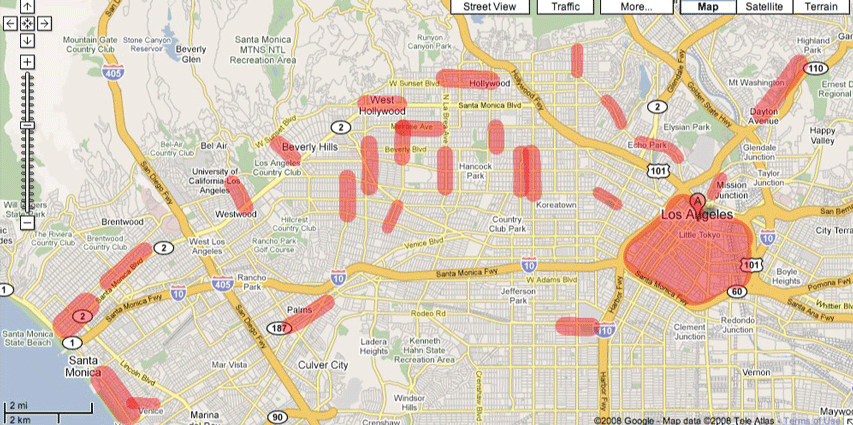June 15, 2012
LA Neighborhoods

Brackets.
Bracketing a map of Los Angeles' budding pedestrian communities with two videos showcasing alternative private/public transportation seemed like a natural way to frame a blogpost that argues for the nurturing and development of pedestrian friendly neighborhoods across the Los Angeles metropolitan area from downtown to the Pacific.
To say that Los Angeles is a young city (incorporated as a municipality in 1850) is an understatement. Today, LA is in its infancy. LA has been thickening up in recent years, it's hard to miss the proliferation of multistory apartments across the city. More and more, people are living nearer their workplace and neighborhoods are sprouting up in parts of the city that are already primed with a sense of place. There are more people riding bikes, I see more and more scooters and motorcycles on the city streets nowadays. Taipei and Barcelona... Los Angeles can sport as many two wheeled vehicles as those cities do with ease! Fewer cc's of engine per person, more vehicles on the road, what's not to like? I celebrate this development and this blogpost encourages it to bloom even more.
My proposal is simple and schematic: help people to get out of their cars on onto the their feet on the street. Pardon me whilst I cut to the chase with three bullet points:
- Parking. People need a safe place to stash their vehicles within a decent proximity to a pedestrian commercial district. Smaller pedestrian zones can employ simple parking lots, larger ones can build parking garages (Santa Monica has a great model that has endured for decades).
- Intra-Neighborhood Transportation. Pedestrians have their limits of endurance and pedestrian neighborhoods come in many sizes. We have a Metro of buses and rail lines that range across the city and we are building them bigger, but what is missing is local public transportation (people still need to access -sans cars- the stations of the Metro system, now so widely spread apart), and what I would like to suggest is for the city to embrace the private kind: jeepneys, tuk-tuk's, or any modern form of the rickshaw or its variants. Privately owned transportation businesses can naturally scale up or down according to the local economy. Civic regulation of these businesses should be simple yet comprehensive and designed to assist budding entrepreneurial energy. (I haven't analysed LADOT's regulations, but I'll link it here in case you want to.)
- Nodes and Routes. The previous two issues should be combined into a system of parking nodes and the transportation routes between them. Again, the size of the neighborhood should indicate the scale and complexity of the networks.
A bracket is an enclosure. The sight of people walking the sidewalks is starting to become a normal thing in Los Angeles. It wasn't always this way. When I arrived here in 1985, LA was a fading image of its former self: a car city where everyone could speed across the entire metropolis in 25 minutes. People walking the street was a rarity, confined to Hollywood Boulevard and fewer other locales. Social life was confined to how many people you could fit in a backyard bar-b-que, and not everyone invited made it to the party. Some of this is still a reality here in LA, but less and less so as time goes by. Let's give definition to this emerging new reality and help it grow.
A pipe dream and another message in a bottle. Spread the word, talk to your representatives in government.
Posted by Dennis at June 15, 2012 5:22 PM
Leave a comment